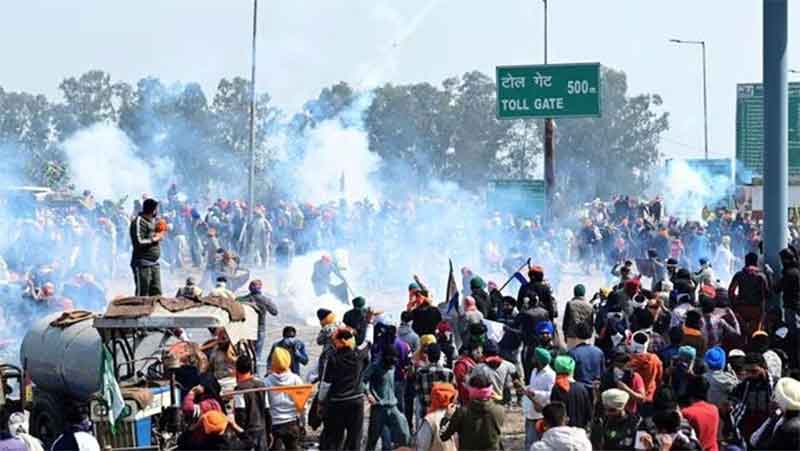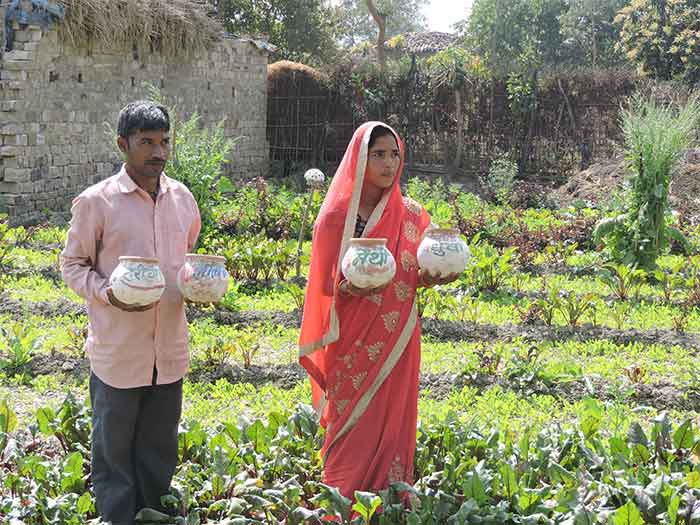
What might a future India look like? If current policies continue, it could mean dozens of mega-cities with up to 40 million inhabitants and just two to three hundred million (perhaps 15-20% of the population) left in an emptied-out countryside. It could also mean hundreds of millions of former rural dwellers without any work and thus anywhere decent to live in these cities.
And what about the countryside? Given the trajectory the country seems to be on, it does not take much to imagine vast swathes of chemically-drenched monocrop fields containing genetically modified plants or soils rapidly turning into a chemical cocktail of proprietary biocides, dirt and dust.
Thanks to the model of agriculture being supported and advocated by neoliberal ideologues under the banner of ‘growth’, it also does not take much to imagine a state of near-permanent drought, spiralling rates of illness throughout the population due to bad diets, denutrified food and agrochemical poisoning.
Monsanto-Bayer and other transnational corporations will decide on what is to be eaten and how it is to be produced and processed. From seed to field to plate, the corporate take-over of the food and agriculture chain will be complete. You can forget any notion of food sovereignty. The existing productive system based on livelihood-sustaining smallholder agriculture and small-scale food processing will be all but a memory as those remaining in the sector will be squeezed, working on contracts for market-dominating global seed and agrochemical suppliers, distributors and retail concerns. Independent agricultural producers and village level processors will have long been forced out of the system.
Industrial agriculture will be the norm (with all the social, environmental and health devastation and externalised costs that the models brings with it).
Since the 1990s, India seems to have decided to hitch a ride to the future by tying itself to a system of neoliberal globalisation. An unsustainable, crisis-ridden system that fuels national debt and relies on hand-outs (demonetisation) for banks and corporations. A system based on a credit/debt-based consumer economy, financial speculation, derivatives and bubbles, with nations no longer able to carry out their own policies, tied down by undemocratic trade deals, beholden to rigged World Trade Organization rules and following a path prescribed by the World Bank, regardless of any democratic will of the people. A system whereby governments are paralysed to act as both eyes are firmly fixed on ‘market confidence’ and fearful of scaring away companies.
In a future India, international corporations will have long destroyed any real notion of indigenous self-sufficiency, having made a mockery of long-forgotten sound bites about ‘make in India’. People might eventually ask, how did India let this happen to itself?
We do not have to move forward 50 years to look back to see what happened. We already have the answer to why the world has taken a wrong turn.
Economist Dani Rodrik notes how under the Bretton Woods regime nations put restrictions on the flow of capital both inwards and outwards, so that domestic firms and banks could not borrow from banks elsewhere or from international capital markets. They would ask for permission or they would not be permitted. Domestic corporations or banks could not put their money in other countries. They couldn’t simply take the money out. Domestic financial markets were segmented from international or financial markets elsewhere. Governments could run their own macroeconomic policy without being truly encumbered by monetary or fiscal policies elsewhere.
Rodrik argues that this meant governments could also have their own tax policies and own industrial policies without having to worry that capital and international capital would leave. It meant you didn’t have to try to seek market confidence for every policy or worry that if you didn’t have market confidence, capital would flee. There were also restrictions on domestic residents trading on foreign currencies.
However, the dismantling of Bretton Woods and the deregulation of international capital movement (financial liberalisation) has led to the greater incidence of financial crises (including sovereign debt) as well as their severity.
Across the world, ordinary people are reacting to the outcome of neoliberalism. From Greece to the US, people have taken to the streets to protest. In the UK, Jeremy Corbyn has tapped into the popular sentiment that enough is enough. In India, farmers are protesting on the streets.
But what can be done to prevent a future full-fledged neoliberal dystopia taking hold in India?
The authors of this piece in India’s Economic & Political Weekly argue that in agriculture long-term measures could include land reforms and correcting rigged trade that is against the cultivating class. They add:
“Far-sighted and sustained policy initiatives to provide farmers dignified livelihoods are required. In an economy driven by jobless growth, compulsive migration to cities is often a case of distress transhumance. These migrants then become the new “serfs” of the informal services and construction sector, while the existing rural and agrarian problems remain unresolved.”
If such initiatives are not forthcoming, India should look to Mexico to see what is in store. Aside from destroying the nation’s health and home-grown food supply chain, ‘free’ trade under NAFTA allowed subsidised US corn to be dumped in the country, fuelled unemployment and transformed a former productive peasantry into a problematic group.
To avoid similar outcomes, India must delink from capitalist globalisation through capital controls, manage foreign trade to suit its own interests and expand domestic production, which it can achieve by protecting and encouraging indigenous small producers, including smallholder farmers. By encouraging localisation, self-sufficiency and investing in these types of producers, meaningful work can be generated for the majority. The exact opposite of the globalisation agenda (tens of millions of livelihoods are in danger as foreign corporations move in).
Despite the state’s neglect of agriculture, hundreds of millions of people still find sustenance from farming in India. Instead of driving farmers away to the cities, an approach to development must begin by recognising the situation, skills and knowledge already possessed within the agriculture sector. It should not demand that farmers mortgage their lives and wait for decades for jobs that may never arrive. It should not listen to neoliberal dogmatists whose only role is to seek to justify corporate plunder.
Colin Todhunter is an independent writer

















































